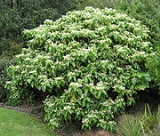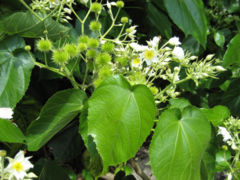
Entelea
Encyclopedia
Entelea arborescens or whau is a species of malvaceous
tree endemic to New Zealand
. E. arborescens is the only species in the genus Entelea. A shrub or small tree to 6 m with large lime
-like leaves giving a tropical appearance, whau grows in low forest along the coast of the North Island
and the northern tip of the South Island
. The dry fruit capsules are very distinctly brown and covered with spines. The common name whau is a Māori
word that appears to derive from the common Polynesian
word for hibiscus
, other malvaceous trees which whau superficially resembles. Alternate names include 'New Zealand mulberry', 'corkwood' and 'evergreen lime'.
, Entelea is placed within tribe Sparrmannieae and subfamily Grewioideae
, a position confirmed by ndhF DNA sequence
data. As is the case with most malvaceous plants, E. arborescens has alternate, stipulate foliage. The bright green obliquely cordate leaves are large (10 to 20 cm long), and have from 5 to 7 nerves and long petioles. The flowers are borne profusely between early spring and mid-summer. They have 4 or 5 sepals and petals. They are 2 cm in diameter, scented, white, with a central bunch of densely-packed yellow stamens. The brown seed capsules, which are 1½ cm long, bear 2½ cm long rigid bristles.
Whau has very light wood, rivalling balsa
(Ochroma pyramidale) for lightness, and less dense than cork
. The wood was used by Māori for the floats of fishing net
s and the like. The pale brown wood forms several bands of unlignified pith-like parenchyma per year. This is a characteristic shared with related plants including Sparrmannia, and means that there are no distinct growth rings in the wood.
 The species is extremely light-demanding and is unable to live under an unbroken canopy. It cannot tolerate even moderate cold, strong wind, or a very dry or ill-drained soil. Its occurrence is sporadic even in undisturbed coastal forest. In lowland rain-forest whau is rare, found only beside streams in valleys near the coast where open ground and sufficient warmth and light are found.
The species is extremely light-demanding and is unable to live under an unbroken canopy. It cannot tolerate even moderate cold, strong wind, or a very dry or ill-drained soil. Its occurrence is sporadic even in undisturbed coastal forest. In lowland rain-forest whau is rare, found only beside streams in valleys near the coast where open ground and sufficient warmth and light are found.
Although whau occurs here and there in Nelson and Marlborough in the South Island
, occurrence is local south of Lat. 38°. The plant has never been found more than 8 km. from the sea (Waitākere Stream, near Auckland), nor higher than 350 m. Extreme minimum temperatures for localities where Entelea really thrives are always, so far as the records show, well above 0°C.
most quickly, followed by Beilschmiedia tawa.
, whau can be grown outdoors in sun or light shade in mild climates, or in a conservatory or glasshouse in cold climates. It is intolerant of drought and is able to withstand barely 3°C of frost. Propagation is from seed, which is available commercially.
Malvaceae
Malvaceae, or the mallow family, is a family of flowering plants containing over 200 genera with close to 2,300 species. Judd & al. Well known members of this family include okra, jute and cacao...
tree endemic to New Zealand
New Zealand
New Zealand is an island country in the south-western Pacific Ocean comprising two main landmasses and numerous smaller islands. The country is situated some east of Australia across the Tasman Sea, and roughly south of the Pacific island nations of New Caledonia, Fiji, and Tonga...
. E. arborescens is the only species in the genus Entelea. A shrub or small tree to 6 m with large lime
Lime (fruit)
Lime is a term referring to a number of different citrus fruits, both species and hybrids, which are typically round, green to yellow in color, 3–6 cm in diameter, and containing sour and acidic pulp. Limes are a good source of vitamin C. Limes are often used to accent the flavors of foods and...
-like leaves giving a tropical appearance, whau grows in low forest along the coast of the North Island
North Island
The North Island is one of the two main islands of New Zealand, separated from the much less populous South Island by Cook Strait. The island is in area, making it the world's 14th-largest island...
and the northern tip of the South Island
South Island
The South Island is the larger of the two major islands of New Zealand, the other being the more populous North Island. It is bordered to the north by Cook Strait, to the west by the Tasman Sea, to the south and east by the Pacific Ocean...
. The dry fruit capsules are very distinctly brown and covered with spines. The common name whau is a Māori
Maori language
Māori or te reo Māori , commonly te reo , is the language of the indigenous population of New Zealand, the Māori. It has the status of an official language in New Zealand...
word that appears to derive from the common Polynesian
Polynesian languages
The Polynesian languages are a language family spoken in the region known as Polynesia. They are classified as part of the Austronesian family, belonging to the Oceanic branch of that family. They fall into two branches: Tongic and Nuclear Polynesian. Polynesians share many cultural traits...
word for hibiscus
Hibiscus
Hibiscus is a genus of flowering plants in the mallow family, Malvaceae. It is quite large, containing several hundred species that are native to warm-temperate, subtropical and tropical regions throughout the world...
, other malvaceous trees which whau superficially resembles. Alternate names include 'New Zealand mulberry', 'corkwood' and 'evergreen lime'.
Description
Within the MalvaceaeMalvaceae
Malvaceae, or the mallow family, is a family of flowering plants containing over 200 genera with close to 2,300 species. Judd & al. Well known members of this family include okra, jute and cacao...
, Entelea is placed within tribe Sparrmannieae and subfamily Grewioideae
Grewioideae
Grewioideae is a subfamily of the Malvaceae family.The group is named after its type genus, Grewia, which is named for the English scientist Nehemiah Grew .-External links:*http://species.wikimedia.org/wiki/Grewioideae...
, a position confirmed by ndhF DNA sequence
DNA sequence
The sequence or primary structure of a nucleic acid is the composition of atoms that make up the nucleic acid and the chemical bonds that bond those atoms. Because nucleic acids, such as DNA and RNA, are unbranched polymers, this specification is equivalent to specifying the sequence of...
data. As is the case with most malvaceous plants, E. arborescens has alternate, stipulate foliage. The bright green obliquely cordate leaves are large (10 to 20 cm long), and have from 5 to 7 nerves and long petioles. The flowers are borne profusely between early spring and mid-summer. They have 4 or 5 sepals and petals. They are 2 cm in diameter, scented, white, with a central bunch of densely-packed yellow stamens. The brown seed capsules, which are 1½ cm long, bear 2½ cm long rigid bristles.
Whau has very light wood, rivalling balsa
Balsa
Ochroma pyramidale, commonly known as the balsa tree , is a species of flowering plant in the mallow family, Malvaceae. It is a large, fast-growing tree that can grow up to tall. It is the source of balsa wood, a very lightweight material with many uses...
(Ochroma pyramidale) for lightness, and less dense than cork
Cork (material)
Cork is an impermeable, buoyant material, a prime-subset of bark tissue that is harvested for commercial use primarily from Quercus suber , which is endemic to southwest Europe and northwest Africa...
. The wood was used by Māori for the floats of fishing net
Fishing net
A fishing net or fishnet is a net that is used for fishing. Fishing nets are meshes usually formed by knotting a relatively thin thread. Modern nets are usually made of artificial polyamides like nylon, although nets of organic polyamides such as wool or silk thread were common until recently and...
s and the like. The pale brown wood forms several bands of unlignified pith-like parenchyma per year. This is a characteristic shared with related plants including Sparrmannia, and means that there are no distinct growth rings in the wood.
Distribution

Although whau occurs here and there in Nelson and Marlborough in the South Island
South Island
The South Island is the larger of the two major islands of New Zealand, the other being the more populous North Island. It is bordered to the north by Cook Strait, to the west by the Tasman Sea, to the south and east by the Pacific Ocean...
, occurrence is local south of Lat. 38°. The plant has never been found more than 8 km. from the sea (Waitākere Stream, near Auckland), nor higher than 350 m. Extreme minimum temperatures for localities where Entelea really thrives are always, so far as the records show, well above 0°C.
Ecology
In its natural habitat the tree depends mainly for success upon its prodigious seed production, the remarkably long life of the seed, and, after germination, rapid growth. In forest, whau is essentially a transient, opportunist species. The characteristics which cause it to be effective in such a role include: its ability to quickly occupy ground where light has been temporarily let into the forest; its tremendous rate of growth; its ability to rapidly produce fruit; its enormous seed production, especially as it is about to die; and the fact that its seeds are capable of germinating as soon as the capsules open. Whau seeds can be stimulated into growth by fire after lying on the surface of the ground for many years. Having germinated, whau establishes itself with striking rapidity, and where conditions are favourable, whau is often the first new plant to appear, followed by Urtica ferox, Macropiper excelsum, Coprosma macrocarpa and Coprosma australis. Forest-dominating trees are slower to come in; CorynocarpusKaraka (tree)
Karaka , is an evergreen laurifolia tree, of the family Corynocarpaceae, with large glossy leaves endemic to New Zealand, where it is widespread in mainly coastal situations, often forming a major component of coastal forest, although it is rarely a dominant tree...
most quickly, followed by Beilschmiedia tawa.
Cultivation
Preferring a rich moist loamLoam
Loam is soil composed of sand, silt, and clay in relatively even concentration . Loam soils generally contain more nutrients and humus than sandy soils, have better infiltration and drainage than silty soils, and are easier to till than clay soils...
, whau can be grown outdoors in sun or light shade in mild climates, or in a conservatory or glasshouse in cold climates. It is intolerant of drought and is able to withstand barely 3°C of frost. Propagation is from seed, which is available commercially.

